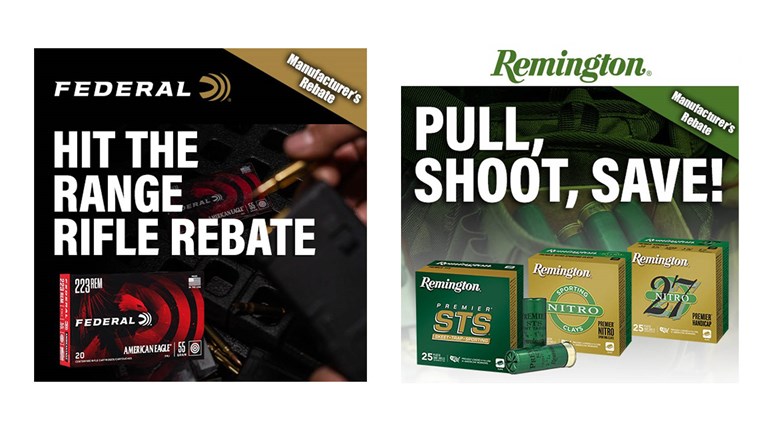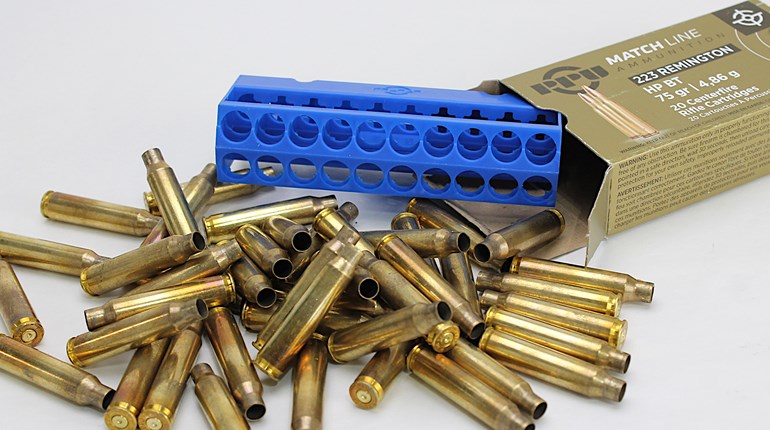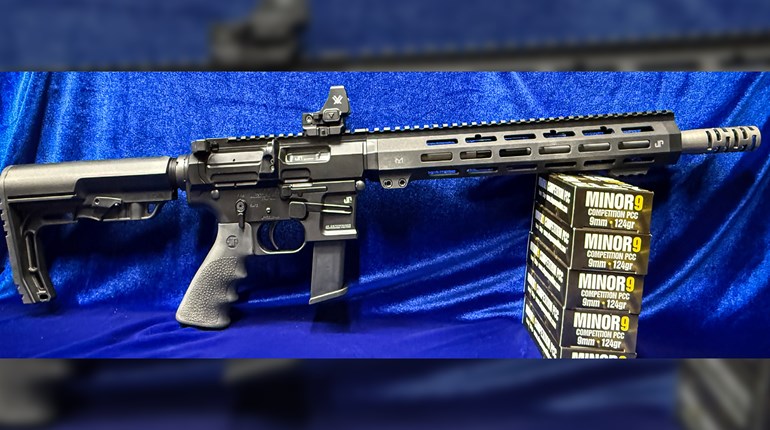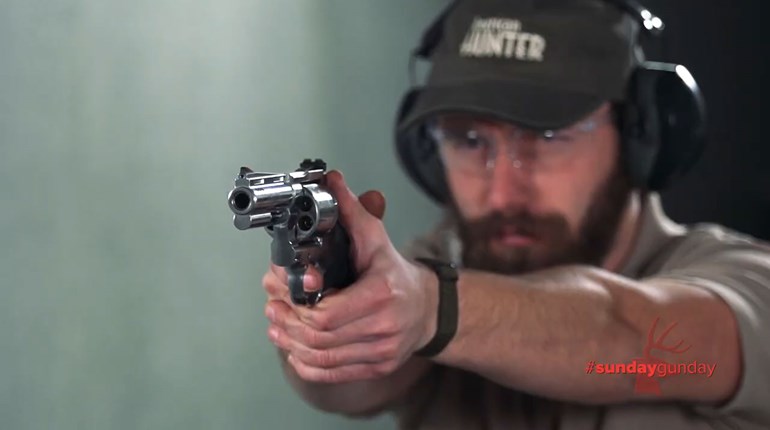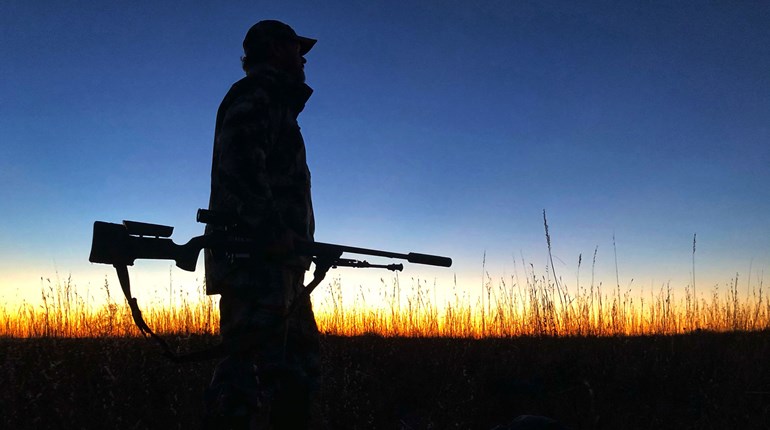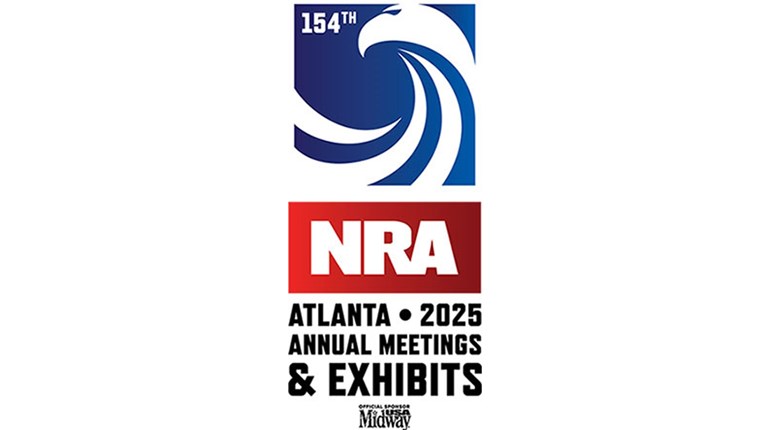
One of the reasons I continue to be a proponent of revolvers for use as trail guns is ammunition flexibility. Wheel guns don't rely on cartridge-generated pressure levels to cycle the action. This means that pressure levels and bullet styles can vary greatly and the gun will keep on trucking until all the rounds in the cylinder have been fired. Different rounds can even be mixed and matched depending on the task at hand.
One specialized type of ammunition which can be particularly handy in some situations is the snake-shot load. Instead of firing a singular bullet, these rounds launch a load of fine lead birdshot. In essence, they temporarily convert handguns into miniature, short-distance shotguns suitable for dispatching too-close-for-comfort pests including venomous snakes, rats, mice and similarly-sized vermin.
For decades this particular corner of the commercial ammunition market has been primarily the domain of CCI Ammunition and its series of Pest Control cartridges. Available in rimfire, semi-automatic and revolver calibers, these rounds are capped off with a blue or red polymer capsule which serves as both container and wad for loads of birdshot that vary in size and weight depending on the cartridge. I've tested and carried CCI’s rounds over the years with positive results.
But this year, DoubleTap Ammunition out of Cedar City, Utah, decided to launch their own take on revolver-sized shot shells, which they aptly dubbed the DT SnakeShot series. Rather than follow in CCI's footsteps, they've taken these cartridges in a different but effective direction.

The company opted to configure the business end of these rounds in a manner used by at-home hand loaders for decades. The mouth of the cartridge case is sealed by crimping it over a copper gas check. These shallow copper cups are more commonly used to cap the base of lead bullets to reduce fouling. This is a time-tested snake shot round configuration which creates a tight seal and uses readily available components which, in turn, keeps costs down.
Behind the gas check is a load of fine #9 lead birdshot. It varies in weight and pellet count depending on the size of the cartridge case. This is yet another traditional hand-loader option which has proven to be quite effective at short distances.
This is where things get interesting. In most cases, folks who roll their own snake shot will place a wad or cardboard disc in between the birdshot and the powder charge in typical shotgun shell fashion. But DoubleTap has opted to replace the wad with what is listed as a 'hardcast full wadcutter.'
Considering their thin front-to-back profile, a more representative description for these wadcutters would be 'hardcast lead defense disks.' However, Winchester already snapped up the 'defense disk' moniker for the pre-flattened, copper-plated lead disks found in their PDX1 Defender .410-bore shells intended for use in .45 Colt/.410-bore handguns. But I digress. DoubleTap's hardcast disks are sized to engage a revolver’s rifling and provide a solid, central hit in addition to the birdshot pattern.

When I met with Mike McNett, President of DoubleTap Ammunition, he mentioned three key goals they wanted to meet with this new snake-shot cartridge series. First off, replacing the polymer capsules favored by CCI with the copper gas checks will reduce the amount of spin picked up from the rifled bore by the shot load. This in turn will lend to tighter shot patterns. And though it has been exceptionally rare in my experience, the translucent capsules can crack, break apart or shift in the cartridge case when handled roughly or stored improperly. This is not an issue with the crimped gas-check configuration.
Secondly, the inclusion of the hardcast lead disk is intended to make these rounds more potent than they would be with birdshot alone. The solids weigh between 40 to 70 grains, depending on the caliber, with all cartridges in the series loaded to a relatively sedate listed muzzle velocity of 1,000-fps The result is a heavier and harder-hitting payload with modest to moderate levels of felt recoil.
Finally, there are the caliber options. CCI's lineup includes rimfire, semi-automatic pistol and some revolver caliber options like .38 Special, .44 Remington Magnum and .45 Colt. But DoubleTap offers these three calibers plus a few more that I have yet to see made available commercially including .32 H&R, .327 Federal Magnum, .41 Remington Magnum and, believe it or not, .500 S&W! Curious to see how these new loads perform, I lined up six of the seven caliber options for a range test.
Range Testing Protocols
Before heading to the range there was the question of how to go about evaluating the performance of the DT SnakeShot loads. For singular projectiles, including revolver bullets, we usually fire three 3-shot or five 5-shot groups per load at a given distance into paper targets and measure the group sizes. This gives us a good idea of what to expect from that particular gun and ammunition combination in regards to repeatable accuracy.
As for testing handguns loaded with birdshot, the protocol is fundamentally different. Just like patterning shot shells fired from a shotgun, we want to get a feel for how the patterns (or spread) change as the shot load travels through the air and at what distance an optimal pattern will usually form. I've been testing .410-bore shells fired though handguns like the Smith & Wesson Governor, Taurus Judge and Bond Arms pistols for quite some time. Because short, rifled handgun barrels cause birdshot to spread very rapidly, it’s informative to fire one round per target (much like shotgun patterning using a greased steel plate) using four targets set at distances of 5, 10, 15 and 20 feet (yes, feet, not yards). With each target providing a snapshot of the pattern change over distance, it's easy to see where that particular gun and shell combination achieve an optimal pattern size.

However, the DT SnakeShot cartridges fire hybrid loads consisting of birdshot and singular projectiles. So I checked in with the American Hunter team, we compared notes and this is what we came up with:
Each caliber was checked for birdshot pattern and hardcast lead solid group sizes by firing five rounds into targets set at 2, 5 and 7 yards. The targets consisted of 34-inches tall by 22-inch-wide paper sheets, with Birchwood Casey Shoot-N-C 8-inch reactive bullseyes affixed centrally to each sheet. The 8-inch bullseye is a good size to represent a coiled snake, rat or similar pest, and it provided a repeatable aiming point for the lead solids. The relatively large paper sheets captured the spreading birdshot nicely. Overall, I would say this freshly minted testing approach for this recently released hybrid cartridge yielded quite useful results.

A recently released Garmin Xero C1 Pro radar chronograph was used to clock the velocity. Simply stated, this is the most portable and simple-to-use chronograph I've worked with over the years, thanks to its cutting-edge technology, compact size and intuitive controls. This chronograph fits into the same storage space as a cell phone and the internal battery will last all day. However, I knew going into this that the DT SnakeShot rounds' dual payload would likely cause some odd readings or, what was more often the case, the shots were dropped from the string. However, each caliber produced at least seven or more clean reads per 15-round string fired next to the Xero C1 Pro, of which five were averaged together for the numbers shown in the results.
Last but not least, I did my best to round up six revolvers that would be as representative of a trail gun cross section as possible. This included single-actions and double-actions from various makers in barrel lengths from 2- to 6-inches in length. I even managed to work in one gun with a ported barrel and another factory configured for micro red-dot optics. Some of these revolvers are guns that are in the process of typical T&E reviews while others are old favorites that I'm happy to work with any chance I get!

The good folks at TNT Guns & Range in Murray, Utah, were kind enough to allow for this hybrid ammunition to be tested at their indoor pistol range. The air conditioning, automated target holders and spacious, private shooting stalls made for a comfortable extended shooting session. However, I called to verify that this type of snake shot cartridge would be permissible to shoot on that particular range. Every facility has their own rules and regulations regarding ammunition, so make sure to check in with the staff before peppering your targets with snake shot loads.
The following sections discuss the range results broken out by cartridge caliber. Please note that in some cases, the copper gas checks hit the targets face on punching nice, neat, bullet-like holes. In these cases it may appear in the photos that the lead solids produced large, sporadic groups. This is not the case, those are just the gas checks adding a bit more to the impact.
.32 H&R Mag: 90-Grain Payload; 1,000-fps Listed 4-Inch Barrel Velocity
In 1984, Harrington & Richardson teamed up with Federal Premium Ammunition to develop a more powerful version of the .32 S&W Long which was dubbed the .32 H&R Magnum. This often overlooked .32-caliber round provides snub-nose revolver performance comparable to the .38 Special but with lower levels of felt recoil. This cartridge's slimmer profile also allows a sixth round to fit into what are usually 5-shot cylinders. In this case, the DT Snakeshot round was fired from a 2-inch barrel stainless steel Taurus Model 327 double-action revolver (see a full review here).

The 90 grain payload consists of 100 pieces of #9 shot and a 40-grain hardcast solid. The 2-inch barrel yielded an average muzzle velocity of 988-fps for 87-ft.-lbs. of energy for the lead solids. Here are the patterning results:
- 2 yards
- Birdshot Pattern: 8.5-inches
- Lead Solids Group: 1.69-inches
- 5 yards
- Birdshot Pattern: 20-inches around the bullseye
- Lead Solids Group: 1.82-inches
- 7 yards
- Birdshot Pattern: top to bottom coverage
- Lead Solids Group: 6.27-inches

.327 Fed. Mag.: 95-Grain Payload; 1,000-fps Listed 4-Inch Barrel Velocity
Released in 2008, the .327 Fed. Mag. is another revolver round developed by Federal Premium Ammunition. It is, for all intents and purposes, a magnum version of the .32 H&R Magnum with performance potential that overlaps the lower end of the .357 Mag. energy scale. Revolvers chambered for the .327 Fed. Mag. can also safely chamber and fire .32 H&R Magnum and .32 S&W Long.
The revolver used to test this load is the new-for-2024 Taurus 327 Defender T.O.R.O. Sporting a matte black finish applied over its stainless steel construction, this small frame 6-shot double-action arrives micro red dot optic ready with the mounting hardware provided. It also ships with a second compact rubber grip (see a full review of this model at NRAWomen.com).

This cartridge's 95-grain payload includes 110 pieces of #9 shot and a 40-grain hardcast solid. Although this round was fired through a slightly longer 3-inch barrel, and the payload is only 5-grains heavier than that of the .32 H&R Mag. load, the velocities were notably slower with an average of just 866-fps This dropped the muzzle energy for the lead solid to 67-ft.-lbs. This was something of a surprise since .327 Fed. Mag. usually runs hotter than .32 H&R Mag. Here are the pattern results:
- 2 yards
- Birdshot Pattern: 8-inches
- Lead Solids Group: 1.89-inches
- 5 yards
- Birdshot Pattern: 19-inches
- Lead Solids Group: 3.48-inches
- 7 yards
- Birdshot Pattern: top to bottom coverage
- Lead Solids Group: 2.05-inches

.38 Special: 130-Grain Payload; 1,000-fps Listed 4-Inch Barrel Velocity
No snake-shot cartridge series would be complete without a round sized for .38-caliber revolvers. It's a great solution for folks who already pack short-barrel, J-frame size revolvers for personal protection. Just swap out one or two hollow points for the snake shot, put the gun back in the holster you prefer and you are ready for the trail.

These rounds will also fit and fire from .357 Mag. trail guns. That's why for this evaluation the round was test fired using a Taurus 692 caliber-convertible double-action which ships with a second quick-swap 9 mm cylinder. This particular model has a ported barrel which proved to be perfectly compatible with this round (check out the full T&E review here).
The 130-grain payload is divided between 160 pieces of #9 shot and a 50-grain lead solid. The average velocity was 979-fps lending the lead solid a muzzle energy of 106-ft-lbs. The patterns turned out like this:
- 2 yards
- Birdshot Pattern: 9-inches
- Lead Solids Group: 0.97-inches
- 5 yards
- Birdshot Pattern: 23-inches
- Lead Solids Group: 2.79-inches
- 7 yards
- Birdshot Pattern: top to bottom coverage
- Lead Solids Group: 3.94-inches

.41 Rem. Mag.: 175 Grain Payload; 1,000-fps Listed 4-Inch Barrel Velocity
Back in 2016, I tried the .41 Rem. Mag. cartridge on for size and came away from the experience a convert. Developed in the early 1960s by Bill Jordan and Elmer Keith, it was intended to fill the performance gap in between the .357 Mag. and the .44 Mag. Unfortunately, it did not catch on. It has since slipped into being a niche handgun-hunting cartridge that, while not gone, is often forgotten.
I kept the blued, 4.62-inch barrel Ruger New Model Blackhawk used for my first outing and eventually sent it off to Fords Custom Guns to be lavishly laser engraved and treated to a bright nickel finish (read about it here). I didn't intend for this single-action to be gun-safe ballast after it was gussied up, so it was put to work as part of this evaluation.

This cartridge's 175-grain payload is divided between 240 pieces of #9 shot and a 55-grain hardcast solid. From this revolver it developed 925-fps of velocity for 122 ft-lbs. of muzzle energy for the solid. With this and the other two larger calibers, the combination of the notable increase in birdshot pellet count and the solids caused ragged holes to form in the center of the targets at 2 yards:
- 2 yards
- Birdshot Pattern: 8.5-inches
- Lead Solids Group: 3.16-inches (ragged hole)
- 5 yards
- Birdshot Pattern: 18-inches
- Lead Solids Group: 6.06-inches
- 7 yards
- Birdshot Pattern: 23-inches
- Lead Solids Group: 5.16-inches

.44 Mag.: 200-Grain Payload; 1,000-fps Listed 4-Inch Barrel Velocity
There's little more to be said about the cartridge which once held the title of 'most powerful handgun in the world.' Despite harder-hitting revolver rounds now being available, the good ol' .44 Mag. still holds its own due to a top-notch balance of performance potential, still-manageable levels of recoil and an extensive selection of revolvers to choose from.
For this trip to the range, I broke out a 6-inch barrel Smith & Wesson Model 629-6 manufactured in the early 2000s. Due to its stainless steel construction and rubber grip, instead of the classic blued steel and wood gripped Model 29 of Dirty Harry fame, I couldn't officially squint and ask if anyone was feeling particularly lucky. But I felt lucky shooting it since it balances so nicely and has a smooth trigger.

This round's payload boasts a substantial 260 pieces of #9 birdshot along with a 70-grain hardcast solid which left the 6-inch barrel traveling 1033-fps, with the lead solid exerting 166-ft-lbs. of energy at the muzzle. This was the longest barrel in the test set and I was curious to see how it might affect the birdshot patterns. As it turned out, the patterns were not significantly different from those of the 4.62-inch barrel revolvers:
- 2 yards
- Birdshot Pattern: 9-inches
- Lead Solids Group: 2.5-inches
- 5 yards
- Birdshot Pattern: 18-inches
- Lead Solids Group: 3.64-inches
- 7 yards
- Birdshot Pattern: 25-inches
- Lead Solids Group: 5.33-inches

.45 Colt: 220-Grain Payload; 1,000-fps Listed 4-Inch Barrel Velocity
The 150-year old .45 Colt cartridge has proven to be an impressively resilient and flexible cartridge. This is due in part to the relatively copious cartridge case. Today's diverse selection of powders allow this round's power levels to fluctuate from the soft shooting 'cowboy loads,' favored by single-action shooting-sports competitors, all the way up the .45 Colt +P loads with performance levels somewhere between those of full-power .44 Mag. and .454 Casull cartridges.
For this evaluation, I oiled up a 1990s-era blued-steel 4.62-inch barrel Ruger Blackhawk that I picked up used a long time ago. There's nothing 'nifty' about this gun except for the fact that I really enjoy shooting it when I can, and that the bluing has taken on a plum-colored hue that some older guns get, which looks fantastic!

The cartridge case for this member of the series is spacious enough to hold a 220-grain payload made up of 300 pieces of #9 birdshot and a 70-grain hardcast solid. However, like the .327 Fed. Mag. round in this series, it exhibited a notably slower-than-listed muzzle velocity of 886-fps for a lead solid energy level of 122-ft-lbs. Here are the pattern results:
- 2 yards
- Birdshot Pattern: 8.5-inches
- Lead Solids Group: 3-inches (ragged hole)
- 5 yards
- Birdshot Pattern: 18-inches
- Lead Solids Group: 6.44-inches
- 7 yards
- Birdshot Pattern: top to bottom coverage
- Lead Solids Group: 6.92-inches

Wrapping Up
Let's summarize by going back over the three production goals mentioned earlier for the new DoubleTap Ammunition DT SnakeShot cartridge series. Does the use of a copper gas check in place of a polymer capsule tighten up the birdshot patterns? Because I have yet to test CCI Pest Control rounds using the same 5-shot, three-target protocol applied here I simply don't have enough information for a definitive answer.
So let's shift the question just a bit to fit the data available: Do these rounds yield effective birdshot patterns when fired from typical revolvers? If we average the pattern sizes for all six calibers, fired from a half-dozen different revolvers, the 2-yard birdshot patterns hover right around 8.5-inches in size. This should be devastating to just about any and all pests in its path. At 5-yards, birdshot patterns open up to an average spread of 19-inches for a larger but still effective pellet count for the intended target. At 7-yards the patterns have dispersed enough to produce thin coverage essentially covering the paper targets from top to bottom with only a few pellets landing on the 8-inch bullseye. Based on these patterns, it looks like the optimal pattern zone for the SnakeShot loads is between 2 to 5-yards. That works for me.
What about the hardcast lead disks group sizes? The rule-of-thumb that I follow for acceptable defensive accuracy are bench-rested 5-shot group averages of around 3- to 3.5-inches at a given distance. Groups smaller than 3-inches are a good thing. But when they get to be 4-inches or larger, then we are starting to move past an optimal distance. If the 5-shot groups are all averaged together, like the birdshot patterns, at 2-yards they average 2.20-inches with a 5-yard average of just over 4-inches. At 7-yards, groups were around 5-inches in size. Across the board, the hardcast lead disks demonstrated an optimal accuracy potential of around 5-yards. For this ammunition's intended uses, it gets another thumbs up.
As for the often neglected revolver caliber options, the .41 Rem. Mag. and .327 Fed. Mag. are two calibers I enjoy that don't get as much attention as they deserve these days. Revolver enthusiasts, including me, appreciate that DoubleTap didn't forget the niche caliber fans when launching this ammunition series. I have a little Ruger SP101 6-shot .327 Fed. Mag. that was slicked up and tricked out as a trail-to-town gun for me a couple of years ago by Finks Custom Guns. All it’s needed to be a complete trail package are the .32-caliber DT SnakeShot loads. For more information, visit doubletapammo.com.













